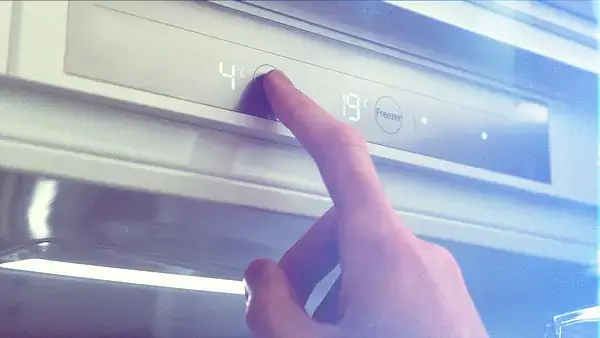Your fridge has a 1-7 temperature range, and you are confused about what is the coldest setting on a fridge 1-7. Such confusion is common, and you are not alone in this confusion. The dilemma is real, my friend. But don’t worry, we’ve got you covered.
In general, 7 is the coldest, and 1 is the warmest. 0 is totally off. However, this is true when the indicator numbers are marked clockwise, and the dial goes from 1 on the left and 7 on the right. In some fridges, the numbers are marked in degrees Centigrade. In such cases, 1 is the coldest, and 7 is the warmest. Do a real test to understand which one is colder.
You can use a fridge thermometer to test it. Set the dial 7 and wait for 10 minutes, then set the dial 1 and wait for 10 minutes to see the result in the fridge thermometer. We will explain everything in detail. Hold on tight.
The temperature settings on your fridge like a volume dial may look straightforward. The higher the number, the louder the music, right? Not so fast! Strap in, we’re about to embark on a chilly journey into the icy depths of your refrigerator to find out what those numbers actually mean.
Table Of Contents
- Understanding Fridge Temperature Settings
- Recommended Temperature Range for Optimal Food Storage
- How to Adjust the Temperature Setting on a Refrigerator?
- Factors to Consider When Setting Refrigerator Temperature
- Check Your Fridge Temperature Using a Thermometer
- Common Mistakes to Avoid When Adjusting Fridge Temperature
- Wrapping Up
- Frequently Asked Questions

Understanding Fridge Temperature Settings
Understanding your fridge’s temperature settings are key in keeping your food fresh and your energy bills low. Let’s dive in and find out what is the coldest setting on a fridge 1-7.
1-2 Temperature Range
This is the warmest internal temperature for a fridge. You should use it for a new fridge or one with nothing inside. Set it to level 2 for a small thing to be cool.
3-5 Temperature Range
This range is suitable for a regular family. You keep daily things and open them when needed. Keep it 5 for items such as raw meat or poultry. However, some fridges come with the maximum 5 range. In such cases, consider 3 as the middle point.
5-7 Temperature Range
For heavy stuffing or other foods that spoil quickly, use this range. It is the coldest level of a fridge. But try to avoid it unless necessary. It will prevent the food from getting frozen. It is also not recommended by manufacturers.
Recommended Temperature Range for Optimal Food Storage
The “best” setting for your fridge, in most cases, is right in the middle. A setting of 4 or 5 is typically the sweet spot, maintaining a safe temperature without freezing your lettuce or spoiling your milk.
FDA suggests keeping the temperature below 40 degrees F or 4 degrees Celsius. Keep the freezer temperature 0° F (-18° C). This temperature prevents or slows the growth of bacteria that make the food unsafe or spoil.
However, remember that some specific foods, such as raw meat and poultry, require lower temperature to slow down the growth of those harmful microbes. Also, eating those perishable foods as soon as possible is recommended without storing them for too long.
Check out the temperature chart for a better understanding.
| Item | Recommended Temperature |
|---|---|
| Fresh meat/poultry/fish | Below 41°F or 5°C |
| Live shellfish | Below 45°F or 7°C |
| Eggs | Below 45°F or 7°C |
| Milk and other Dairies | Below 41°F or 5°C |
| Ice cream | 6-10°F (-14°C -12°C) |
| ROP food | Below 41°F or 5°C |
| Dry food | 50-70°F (10°C -21°C) |
Use the thermometer to set the temperature to the desired level. The dial should also have the temperature markup for easy navigation. Adjusting your fridge temperature should be a gradual process. Don’t crank it up to 7 if you notice your milk is a bit warm. Instead, move it up by one and give it time to adjust before turning it up again.
How to Adjust the Temperature Setting on a Refrigerator?
Adjusting the temperature is easier. Your fridge has a dial thermostat, sliding gauge thermostat, or a digital display to control the temperature. Follow the steps below.
Adjust Temperature using Dial Thermostat
The dial thermostat will have a 1-5, 1-6, 1-7, or even a 1-10 range. Start with the middle range according to the manufacturer’s recommendation.
- Dial the thermostat clockwise right to decrease the temperature.
- Dial it opposite to the clock to increase the temperature.
Of course, it may be the opposite, depending on the fridge setting. So check the manual.
Adjust Temperature using Sliding Gauge Thermostats
You will find the cold or warm signs on the two sides of the gauge thermostat. Usually, cold is located to the right and warm to the left.
- Find the sliding gauge thermostat.
- Slide it right for a colder temperature and left for a warmer temperature.
- Adjust it to the optimal level. Look for the tick mark since that is the standard for that fridge.
Adjust Temperature using Digital Display Control
The latest fridges come with digital display controls. These are easy to control. To do that,
- Go to the temperature control panel.
- You will see plus (+) and minus (-) signs.
- Click plus for warmer temperatures and minus for colder temperatures.
Follow the steps below for other digital panels, such as Whirlpool and others.
- Find the control panel.
- Press the cooling on/off button.
- Click multiple times to reach the recommended temperature.
Factors to Consider When Setting Refrigerator Temperature
Setting the right temperature for your refrigerator isn’t a guessing game. There are several factors that can guide you in finding an appropriate setting for your fridge’s temperature. Let’s dive in and explore them, shall we?

Check Your Fridge Temperature Using a Thermometer
Ever wondered if your fridge is really as cool as it claims to be? It’s time to play detective and find out! Using a thermometer to check your fridge temperature is as simple as pie, and it’s a surefire way to ensure your food is chilling out at the right temperature.
Remember: Consistency is key! To keep your food fresh and safe, aim to keep your fridge temperature as steady as possible. Regular checks with your trusty thermometer can help ensure your fridge is always on point.
Common Mistakes to Avoid When Adjusting Fridge Temperature
Adjusting the fridge’s temperature may seem like a simple task, however, there are a few common mistakes that we often make without realizing. These mistakes can affect your fridge’s efficiency and the freshness of your food. Let’s dive into what they are:
Wrapping Up
Understanding the different temperature settings in your fridge is important to ensure optimal food storage and preservation temperature. It’s all about finding that sweet spot where your perishables are perfectly chilled, but not ice-encrusted. Keep this in mind, every fridge is different, and what works for one might not work for another.
Check manually to be sure since different fridges may have different temperature settings. Make sure you know when to use which temperature. Consider the amount of food stored in the fridge while adjusting the temperature. Remember that using the right temperature will keep your food fresh and safe. It also prevents the food from spoiling and extends the fridge’s life.
